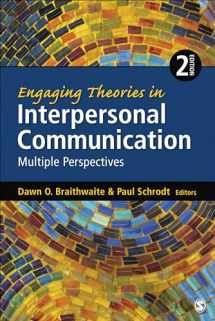
Engaging Theories in Interpersonal Communication: Multiple Perspectives
ISBN-13:
9781452261409
ISBN-10:
1452261407
Edition:
2
Author:
Dawn O Braithwaite, Paul Schrodt
Publication date:
2014
Publisher:
SAGE Publications, Inc
Format:
Paperback
472 pages
FREE US shipping
Rent
35 days
Due Jun 07, 2024
35 days
from $125.00
USD
Book details
ISBN-13:
9781452261409
ISBN-10:
1452261407
Edition:
2
Author:
Dawn O Braithwaite, Paul Schrodt
Publication date:
2014
Publisher:
SAGE Publications, Inc
Format:
Paperback
472 pages
Summary
Engaging Theories in Interpersonal Communication: Multiple Perspectives (ISBN-13: 9781452261409 and ISBN-10: 1452261407), written by authors
Dawn O Braithwaite, Paul Schrodt, was published by SAGE Publications, Inc in 2014.
With an overall rating of 4.1 stars, it's a notable title among other
Communication
(Words, Language & Grammar , Communication & Media Studies, Social Sciences, Sociology) books. You can easily purchase or rent Engaging Theories in Interpersonal Communication: Multiple Perspectives (Paperback) from BooksRun,
along with many other new and used
Communication
books
and textbooks.
And, if you're looking to sell your copy, our current buyback offer is $0.49.
Description
Use and Understand Interpersonal Communication Theories
Engaging Theories in Interpersonal Communication: Multiple Perspectives highlights key theories used to guide interpersonal communication research. The Second Edition features 30 theory chapters written by leading scholars in interpersonal communication, including new coverage of evolutionary theories, Problematic Integration Theory, supportive communication theories, Theory of Motivated Information Management, critical approaches to interpersonal communication, and Media Multiplexity Theory. Each theory chapter follows the same structure to help readers easily find and compare information across theories. An updated introductory chapter maps the history and the current state of interpersonal communication theory since publication of the first edition, based on comprehensive analysis of published scholarship. Presenting both classic and cutting-edge issues, the book organizes theories into three clusters—theories that are individually-centered; theories that are focused on discourse and interaction processes; and theories that examine how communication functions in personal relationships. All authors interweave abstract theoretical concepts with concrete examples in order to maximize readability and comprehension.
Engaging Theories in Interpersonal Communication: Multiple Perspectives highlights key theories used to guide interpersonal communication research. The Second Edition features 30 theory chapters written by leading scholars in interpersonal communication, including new coverage of evolutionary theories, Problematic Integration Theory, supportive communication theories, Theory of Motivated Information Management, critical approaches to interpersonal communication, and Media Multiplexity Theory. Each theory chapter follows the same structure to help readers easily find and compare information across theories. An updated introductory chapter maps the history and the current state of interpersonal communication theory since publication of the first edition, based on comprehensive analysis of published scholarship. Presenting both classic and cutting-edge issues, the book organizes theories into three clusters—theories that are individually-centered; theories that are focused on discourse and interaction processes; and theories that examine how communication functions in personal relationships. All authors interweave abstract theoretical concepts with concrete examples in order to maximize readability and comprehension.


We would LOVE it if you could help us and other readers by reviewing the book
Book review

Congratulations! We have received your book review.
{user}
{createdAt}
by {truncated_author}


